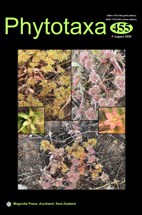Abstract
During our studies of the genus Lepiota in northern Thailand we collected a putatively new species with a distinct morphology and ITS nrDNA profile from Chiang Mai Province. The new species, Lepiota condylospora, is characterized by the presence of reddish brown to brownish orange or brown squamules on the pileus surface, triangular basidiospores with two lateral knobs, and a hymenidermal pileipellis composed of broadly to narrowly clavate elements. Two genetically distinct species of Lepiota section Lilaceae having triangular spores with two lateral knobs are compared with L. condylospora: Lepiota fraterna, from Papua New Guinea, differs in having larger basidiospores and cheilocystidia; while L. cristata var. macrospora, from China, has bigger basidiomata. A full description, color photographs, line drawings and a phylogenetic tree to show the position of the new species are provided.

